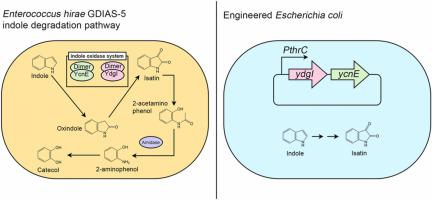Journal of Hazardous Materials ( IF 13.6 ) Pub Date : 2023-05-29 , DOI: 10.1016/j.jhazmat.2023.131707 Jun-Jin Deng 1 , Jing-Yi Hu 2 , Xue-Ying Han 2 , Yang Li 3 , Xiao-Chun Luo 2 , Zhi-Lin Wang 3 , Jia-Zhou Li 4

|
Animal farming copiously generates indoles, which contribute to odor and pose a challenge for deodorization. While biodegradation is widely accepted, there is a lack of suitable indole-degrading bacteria for animal husbandry. In this study, we aimed to construct genetically engineered strains with indole-degrading abilities. Enterococcus hirae GDIAS-5 is a highly efficient indole-degrading bacterium, which functions via a monooxygenase YcnE presumably contributes to indole oxidation. However, the efficiency of engineered Escherichia coli expressing YcnE for indole degradation is lower than that of GDIAS-5. To improve its efficacy, the underlying indole-degradation mechanisms in GDIAS-5 were analyzed. An ido operon that responds to a two-component indole oxygenase system was identified. In vitro experiments showed that the reductase component of YcnE, YdgI, can improve the catalytic efficiency. The reconstruction of the two-component system in E. coli exhibited higher indole removal efficiency than GDIAS-5. Furthermore, isatin, the key intermediate metabolite in indole degradation, might be degraded via a novel isatin-acetaminophen-aminophenol pathway involving an amidase whose coding gene is located near the ido operon. The two-component anaerobic oxidation system, upstream degradation pathway, and engineering strains investigated in this study provide important insights into indole degradation metabolism and offer efficient resources for achieving bacterial odor elimination.
中文翻译:

通过海拉肠球菌 GDIAS-5 的双组分吲哚加氧酶系统降解吲哚
畜牧业会产生大量吲哚,会产生异味,给除臭带来挑战。虽然生物降解被广泛接受,但缺乏适合畜牧业的吲哚降解细菌。在这项研究中,我们的目标是构建具有吲哚降解能力的基因工程菌株。希拉肠球菌GDIAS-5 是一种高效的吲哚降解细菌,其通过单加氧酶 YcnE 发挥作用,可能有助于吲哚氧化。然而,表达YcnE的工程大肠杆菌降解吲哚的效率低于GDIAS-5。为了提高其功效,分析了 GDIAS-5 中潜在的吲哚降解机制。鉴定出响应二元吲哚加氧酶系统的ido操纵子。体外实验表明,YcnE的还原酶成分YdgI可以提高催化效率。在大肠杆菌中重建的双组分系统表现出比 GDIAS-5 更高的吲哚去除效率。此外,吲哚降解中的关键中间代谢物靛红可能通过一种新的靛红-对乙酰氨基酚-氨基苯酚途径进行降解,该途径涉及编码基因位于 ido 操纵子附近的酰胺酶。本研究研究的双组分厌氧氧化系统、上游降解途径和工程菌株为吲哚降解代谢提供了重要的见解,并为实现细菌气味消除提供了有效的资源。



























 京公网安备 11010802027423号
京公网安备 11010802027423号